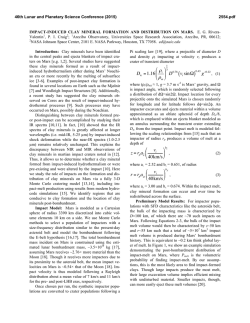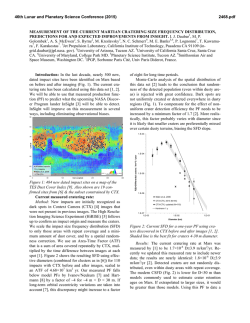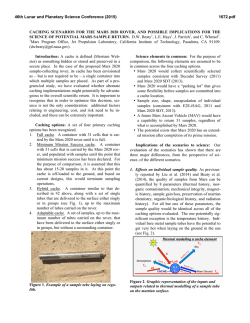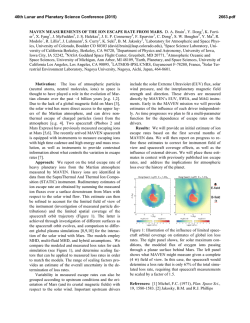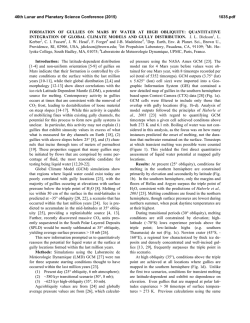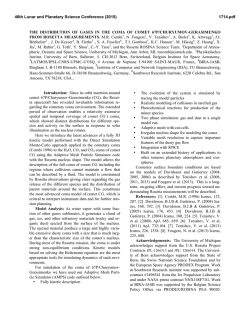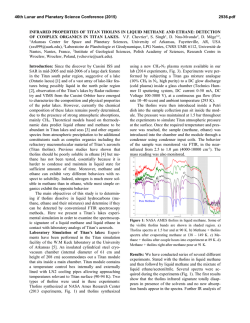
Open-Basin Lakes and the Climate and Surface Environment of
46th Lunar and Planetary Science Conference (2015) 1880.pdf OPEN-BASIN LAKES AND THE CLIMATE AND SURFACE ENVIRONMENT OF EARLY MARS. C. I. Fassett1, T. A. Goudge2, J. W. Head2, and J. F. Mustard2, 1Dept. of Astronomy, Mount Holyoke College, South Hadley, MA ([email protected]), 2Dept. of Earth, Environmental and Planetary Sciences, Brown University, Providence, RI. Introduction: The existence of probable lakes on Mars has been recognized for more than two decades [1-4]. Lakes can either be open-basins with both inlet valley(s) and an outlet valley [e.g., 5], or they can be closed-basins that lack an outlet [e.g., 6]. Although both open- and closed-basin lakes were likely present on early Mars, open-basin lakes are easier to study, and we can have higher confidence that they once held ponded water. Outlet valleys are recognizable in remotely sensed topography and images because they cross drainage divides and are often significantly incised. When an outlet is observed, we can be very confident that a lake must have existed, because overtopping of the drainage divide is what allowed the outlet valley to form in the first place. We can also easily measure the minimum lake volume and surface area. In this abstract, we discuss and synthesize observations of open-basin lakes formed by valley networks, and consider their implications for the early Mars climate and surface environment. Lake Population: In 2008, a global catalog of probable open-basin lakes was created [5]; this was later re-examined by [7]. We required that candidate lakes meet two requirements: (1) they must be local topographic lows, outlined by a closed contour within which water would pond, and (2) they must be fed by input valley network(s). This first requirement is met in abundance on Mars largely because of the numerous impact craters on the surface; not every candidate open-basin lake is in an impact crater, but the majority are. The second criterion limits us to lakes formed as a result of, and contemporaneous with, valley networks. This excludes impoundments related to outflow channels. Our current catalog (Fig. 1) of candidate openbasin lakes has 229 such features, >90% of which we classify as “confident” identifications [7]. Lakes range in scale over at least five orders of magnitude in area (~2 to 500,000 km2) and seven orders of magnitude in volume (~0.02 to 200,000 km3). The largest of these lakes are comparable in size to small seas on Earth. Observational Constraints and Climate Implications: Resurfacing, preservation, and interior deposits: As a population, the candidate open-basins appear to have experienced significant resurfacing after the period of lacustrine activity due to volcanism, glaciation, impacts, and aeolian activity [7]. Post-lacustrine volcanism appears to be particularly important, with at least 40% of open-basins showing signs of volcanic resurfacing [7,8]. Approximately one-third of the catalogued basins have potential lake-related sediments in their interior, and only ~10% of the open-basin lakes have probable deltas [7]. It remains uncertain whether the limited population of deltas is primary and related to sedimentologic/hydrologic factors during the period of fluviolacustrine activity [9,10], or results from poor preservation due to post-lacustrine resurfacing and modification. Even where potential sedimentary facies are observed in open-basins, in situ aqueous alteration and evaporite mineral formation appears to have been unimportant [7,11]. This lack of evidence for in situ alteration and mineral precipitation may be an indication that lacustrine activity was short-lived (and/or ended abruptly), or it may be the result of unsuitable water chemistry for mineral precipitation or alteration in these systems. Lake Chains: Many of the open-basin lakes we map are part of integrated lake-chain systems where the outlets of other open-basins are input valleys to basins that are candidate lakes downstream [5]. Indeed, the longest possible pathways for surface water on Mars are thousands of kilometers long and connected through open-basins. This is quite unlike typical terrestrial drainage networks and is symptomatic of the general immaturity of drainage basin development on Mars. However, the absence of plate tectonics and associated orogenesis is potentially an important factor that makes it more difficult to develop mature drainages on Mars than Earth. The Largest Open-Basin Lakes: The largest openbasin lakes have volumes of 3×104 km3 (Antoniadi, Tikhonravov, and Cassini craters) to 2×105 km3 (Eridania, [12]), and watershed areas of ~105 km2 to 2×106 km2. The resulting lake volume/watershed area ratios for these systems are ~50-300 m (see [5], Table 2). If surface hydrology was solely responsible for filling these lakes, the lake volume/watershed ratios can be thought of as an equivalent runoff depth required to fill these lakes (assuming perfectly efficient runoff and no evaporative or infiltration losses). Alternatively, groundwater (sourced by infiltration outside the local watershed) may have been an important source to these largest lakes [5]. If so, the integration of surface and subsurface hydrology is a strong 46th Lunar and Planetary Science Conference (2015) argument for surface conditions above the freezing point of water on an annual-average basis for at least some period of time on early Mars. Recharging groundwater requires that water be able to infiltrate through the crust, which cannot occur with a globally intact cryosphere. Observations of open-basin lakes are not the only reason to suspect that groundwater transport and surface-subsurface coupling were potentially important on early Mars [e.g., 13-15], but they are consistent with this hypothesis. Climate models [16] that continue to suggest that early Mars was continuously cold are inconsistent with a globally integrated groundwater system. If these climate models correctly reflect conditions on early Mars, the open-basin lakes would have to have been filled from surface runoff in periods of punctuated warming due to impacts [17] or volcanism [18]. Such punctuated scenarios may have challenges explaining why certain large basins (with relatively small watersheds) end up as overflowing lakes, while other comparable-scale basins remained unbreached. Deluges and Short Climate Excursions (decades to centuries): Hydrological modeling [19] suggest that the observed open-basins are inconsistent with formation of valley networks and associated lakes in a sustained deluge or single short-term climate excursion of tens-to-hundreds of years, such as might be expected following an impact event. Sustained deluges would tend to rapidly integrate the landscape and form more open-basins and outlets than are actually observed [19]. Estimates for the amount of water produced in individual impact events [17] also mobilize too little water to fill the largest lakes. 1880.pdf Whether the climate was warm (so runoff was produced by rain) or cold (so runoff was produced by melting glaciers [20]), observations of both individual open-basins [21] and larger watersheds [19] are easiest to reconcile with at least 105 to 106 years of episodic activity. However, major uncertainties remain. Continued analysis of open basin lakes and their watersheds will help to resolve these questions, leading to a better understanding of Late Noachian climate history. References: [1] Goldspiel, J.M. and Squyres, S.W. (1991) Icarus, 89, 392–410. [2] Cabrol, N.A. and Grin, E.A. (2010) Lakes on Mars, Elsevier. [3] Cabrol, N.A. ad Grin, E.A. (1999) Icarus, 142, 160–172. [4] Cabrol, N.A. and Grin, E.A. (2001) Icarus, 149, 291–328. [5] Fassett, C.I. and Head, J.W. (2008) Icarus, 198, 37–56. [6] Goudge, T.A. et al. (2015) this meeting. [7] Goudge, T.A. et al. (2012) Icarus, 219, 211–229. [8] Goudge, T.A. et al. (2012) JGR, 117, E00J21. [9] Irwin, R.P. et al. (2008) 10.1002/9780470760383.ch19. [10] Hoke, M.R.T. et al. (2014) Icarus, 228, 1-12. [11] Osterloo, M.M. et al. (2010) JGR, 115, E10012. [12] Irwin, R.P. et al. (2004) JGR, 109, E12009. [13] Andrews-Hanna, J.C. et al. (2007) Nature, 446, 163-166. [14] AndrewsHanna, J.C. et al. (2010) JGR, 115, E06002. [15] Wray, J.J. et al. (2011) JGR, 116, E01001. [16] Wordsworth, R. (2013) Icarus, 222, 1-19. [17] Segura, T.L. et al. (2008) JGR, 113, E11007. [18] Halevy, I., and Head, J.W. (2014) Nature Geos., 7, 865-868. [19] Barnhart, C.J. et al. (2009) JGR, 114, E01003. [20] Fastook, J.L., and Head, J.W. (2014) PSS, in press. [21] Buhler, P.B. et al. (2014) Icarus, 241, 130-147. [22] Hynek, B.M. et al. (2010) JGR, 115, E09008. Fig. 1. Location of catalogued open basin lakes (circles) superposed on MOLA topography with valley networks from [22].
© Copyright 2025

